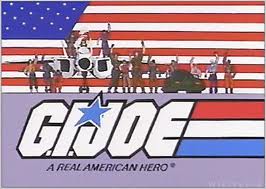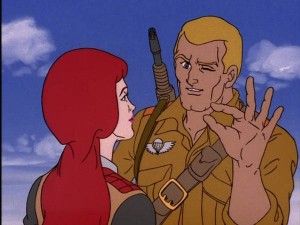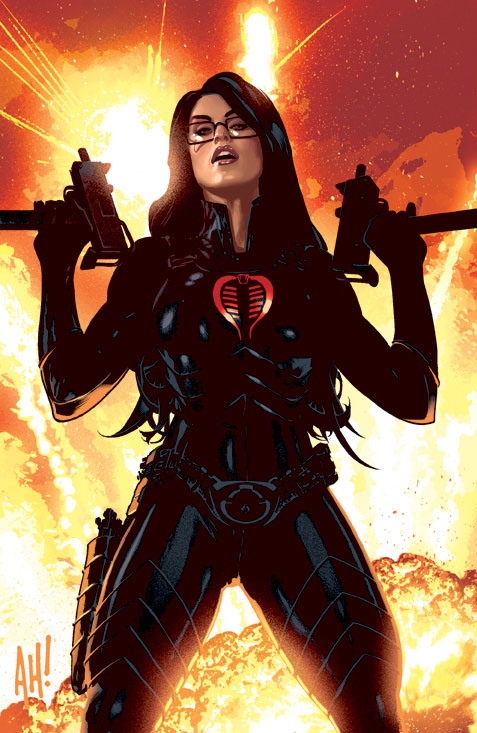Warfare is not the easiest subject matter to adapt to children’s television. Neither is terrorism, and post 9-11, the concepts seem absurdly unthinkable, and yet here we are. The animated G.I. Joe mini-series debuted in syndication in October 1983. It spawned a second mini-series the following year, with the ongoing show premiering in 1985, as well as a host of quirks and a catchphrase, “and knowing is half the battle,” that elicits weird giggles from a specific generation upon hearing it.
 COBRA, the primary enemy of the Joe Team, is fronted by a faceless, shrieking megalomaniac known as the Cobra Commander. They engage in violent activities, most often in airplanes where, most conveniently, everyone parachutes to safety. Bombs, explosions, bullets, ju jitsu, et al, and yet no one gets hurt and no one dies. This is the perfect metaphor for the “Out Of Sight, Out Of Mind” ’80s culture. If you didn’t take the hit, and you didn’t show the wounds, it’s okay.
COBRA, the primary enemy of the Joe Team, is fronted by a faceless, shrieking megalomaniac known as the Cobra Commander. They engage in violent activities, most often in airplanes where, most conveniently, everyone parachutes to safety. Bombs, explosions, bullets, ju jitsu, et al, and yet no one gets hurt and no one dies. This is the perfect metaphor for the “Out Of Sight, Out Of Mind” ’80s culture. If you didn’t take the hit, and you didn’t show the wounds, it’s okay.
There are three things that inform the creation of the series, the first (and perhaps least important) is the original collection of toys under the G.I. Joe banner. The action figure from the early 1960s and 1970s was considerably larger than the ones Eighties kids would come to know — roughly 12 inches in height. They featured “Joe” as a bearded fellow with his khaki fatigues and dogtags. The first run from 1964-1969 was much more Army/Navy, while the second, the “Adventure Team” from 1970-1976 leaned a little more on Joe as a sort of spy, an American James Bond, if you will. The Joe we know has very little to do with these toys, but much more to do with the spy aspect.
When Hasbro created the new line of toys, they were less inclined to base it on military stereotypes and more apt to make it more like one of the most successful action figure lines in toy history: Star Wars. The ’80s Joe figures were smaller and were dressed more like science fiction characters than earthbound warriors. One can only assume that the economics of producing tiny action figures for smaller toy vehicles meant that you could price the items high with a lesser production expenditure.
 The Joes, now a team (to also capture female fans with the addition of Scarlet), also had to have a consistent enemy, and with new markets opening all around the world for American products, no single foreign country was going to be the “bad guy.” So COBRA, an organization bent on world domination, became that oppressor. It was a much safer bet than what would only a decade or so earlier have surely been Russians. The names, the suits, and the accents are all American, but in the midst of the hottest part of the Cold War, with global thermonuclear proliferation dominating the fears of parents and aware children alike, we assumed COBRA to be the Soviet Union. The assumption was never confirmed, but was never strenuously denied either.
The Joes, now a team (to also capture female fans with the addition of Scarlet), also had to have a consistent enemy, and with new markets opening all around the world for American products, no single foreign country was going to be the “bad guy.” So COBRA, an organization bent on world domination, became that oppressor. It was a much safer bet than what would only a decade or so earlier have surely been Russians. The names, the suits, and the accents are all American, but in the midst of the hottest part of the Cold War, with global thermonuclear proliferation dominating the fears of parents and aware children alike, we assumed COBRA to be the Soviet Union. The assumption was never confirmed, but was never strenuously denied either.
COBRA also retained that James Bond-ian supervillain stature of a SMERSH or SPECTRE. The faceless Cobra Commander subbed for Blofeld, who had been most often filmed below the neckline, his hand stroking his white cat. Cobra Commander was a much more active bad guy, but that “mystery man” persona syncs up. But never forget that, even though COBRA was a presumed proxy for the Russian Army, it was also a terrorist organization, and the thought of marketing such a concept to children now is absolutely chilling.
There are other things that are ludicrous about G.I.Joe including the constant stream of violence without consequence, where nobody bleeds, nobody is caught in the exploding vehicle, and every episode has a “happy ending” with the bad guys retreating to fight another day. The buxom, bespectacled Baroness, Cobra Commander’s henchwoman/moll is placed in the series as a counterpart to Scarlet; a bad girl for the good girl to fight. It is strictly a decision based on capturing maximum marketshare. At the same time, the Baroness is in many ways like a dominatrix. Her glasses represent a sort of bookish business-type, but the thigh-high boots and black leather bodysuit, one step beyond Emma Peel, say something entirely different. I suspect designers at Hasbro were having a little more fun in designing this character than usual, and enjoying the secretly perverse nature of slipping her in under the Standards and Practices radar.
 Speaking of which, during this time all TV shows airing in the after-school slot, just before the 5:00 news, had to prove some kind of educational quality or stations would get in trouble. They were required to prove redeeming value for airing programming targeted at kids. How were they to do that with a show about paramilitary forces, a terrorist organization, a ninja, more guns than a Texas WalMart, and a villainess who exhibits S&M tendencies? You take a minute at the end of each episode to promote the value of brushing your teeth, not watching too much TV, being nice to your sister, and not sassing your parents, that’s how. Did you learn something from that bit? Maybe? Great, that’s educational! Wrap it all up by saying, “and knowing is half the battle” and let’s go blow up the White House.
Speaking of which, during this time all TV shows airing in the after-school slot, just before the 5:00 news, had to prove some kind of educational quality or stations would get in trouble. They were required to prove redeeming value for airing programming targeted at kids. How were they to do that with a show about paramilitary forces, a terrorist organization, a ninja, more guns than a Texas WalMart, and a villainess who exhibits S&M tendencies? You take a minute at the end of each episode to promote the value of brushing your teeth, not watching too much TV, being nice to your sister, and not sassing your parents, that’s how. Did you learn something from that bit? Maybe? Great, that’s educational! Wrap it all up by saying, “and knowing is half the battle” and let’s go blow up the White House.
G.I. Joe was fun for what it was: a glorified ad for action figures, replica planes, tanks, and all-terrain vehicles and weaponry. More fun was the spotty, staccato animation and how every now and again the painted colors on characters would just flip. Not a style choice, but more like a miscommunication in the Korean or Japanese animation houses production company Sunbow was contracting out to.
Regardless of the shoestring-budget quality of the productions, children and very bored teenagers lapped it up, and eventually encouraged the team behind G.I. Joe and toymaker Hasbro to debut another toy/show combo, Transformers. Hardly groundbreaking, G.I. Joe and its forbears, like He-Man and the Masters of the Universe, helped make the sub-genre of “television series primarily function as advertising for a product line” a hit, but hardly respectable.







Comments